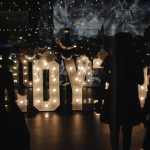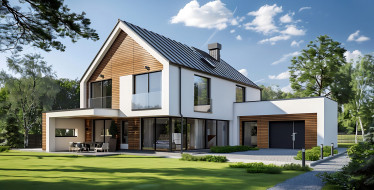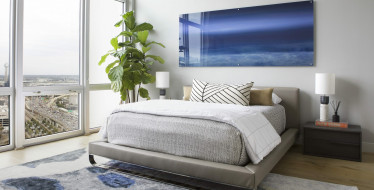Fearless is defined as “free from fear.” Free from fear. Not without fear. Fearlessness in design means to be free from the fear of a client rejecting your design. Free from the fear of sticking up for your design when the pressure to conformity is ever-strong. Free from the fear that saying no to a project will mean saying no to a paycheck. Free from all the fears that stunt creativity, resulting in the absence of the one thing a designer was meant to do — design.
We at Beyond Interior Design have all of these fears. As designers, like many artists and creators, we can feel exposed and vulnerable during a design presentation. To share a project one has spent weeks, months, even years on can be quite scary. Will the client reject it? Will they focus on one aspect and not see the design as a whole? Will my design be too shocking?

Beyond’s Juliana Oliveira, Abbey Latham, and Gary Forsberg getting ready to reveal their design to the client
These are all thoughts that run through our heads, especially as us Beyond designers constantly try to push the envelope on what interior design is. The difference is that we don’t let fear stifle our creative process and, eventually, stop us from presenting the design we know is best for the space. We trust in ourselves, make decisions based on experience, knowledge of the client, and, most importantly, our desire to improve each person’s life through design.
FEAR IN DESIGN
As previously alluded to, the main threats a designer typically faces are economic uncertainty and rejection. And the two play hand-in-hand. Fear of rejection can cause a designer to play it safe with their designs, creating spaces and structures that conform to the status quo. Or, in hopes to appease the client, they’ll produce “designs” based on exactly what the client wants, and that’s it. Yet, it’s not a designer’s job to directly replicate. It’s their job, our job, to study the essence of one’s inspiration, draw from it, and design something better, something unique to the client, and something that no one else could create.
But pushing those boundaries could rub clients the wrong way, and one might lose the project because of that. And that’s how fear of rejection interweaves with fear of economic uncertainty.
Another way fear of economic uncertainty comes into play is at the very beginning. Designers will often take on projects that don’t align with their style, inevitably leading to friction between the designer and client. The professional might also take on projects that compromise the idea of design altogether, which is more concerning. Spaces are permanent (or at least semi-permanent), and they greatly affect the lives of those who inhabit them. It’s a designers responsibility to advocate for these spaces and users. They — we – are the experts, after all.

FEARLESSNESS IN DESIGN
While we’d like to honestly say fear has never clouded our judgment as designers, that’s unfortunately not our story. When we first began, we sometimes took on projects that didn’t align with our style and goals. During client presentations, we might concede too much, completely changing our design direction.
 Neither of these situations proved to be beneficial to us or the client. The client-designer relationship is an intimate and high-pressure one. After all, to create a tailored design, we must know the aspirations, passions, desires of each client. Additionally, the client is investing resources, physical and emotional, into their project, so the stakes are immensely high. If there is any doubt at the onset that a relationship won’t be a fit under those circumstances, it’s better for both parties to recognize that and, for us designers, to recommend they seek a partner that is aligned with their goals.
Neither of these situations proved to be beneficial to us or the client. The client-designer relationship is an intimate and high-pressure one. After all, to create a tailored design, we must know the aspirations, passions, desires of each client. Additionally, the client is investing resources, physical and emotional, into their project, so the stakes are immensely high. If there is any doubt at the onset that a relationship won’t be a fit under those circumstances, it’s better for both parties to recognize that and, for us designers, to recommend they seek a partner that is aligned with their goals.
Additionally, clients hire designers for their expertise. The moment we start to doubt and abandon our designs, the client mirrors our reaction. Imagine if Jackson Pollock listened to critics or potential buyers that his art seemed too random – just a bunch of paint drippings on a canvas. (Pollock was incredibly intentional about his work, but we digress). Had he doubted and retreated from his style, he wouldn’t have become the successful artist he was. His work was uncompromising, and those who appreciated his style gravitated towards that integrity.
Another designer who’s put doubt and fear aside is Mexican architect Frida Escobedo. Upon finishing her architecture education, instead of working for another firm, Frida decided to return to Mexico City to open up her own firm. In the beginning, paid work was few and far between, but she continued designing, consistently submitting works to competitions. Eventually, she earned increasingly more commissions and in 2018, she was selected to design the Serpentine Pavilion in London, an honor bestowed on other greats such as Herzog + de Meuron, Frank Gehry, and Zaha Hadid.
Once we decided to act like Pollock and Escobedo, trust in our designs and be free from the fears that compromised our work, we found our practice and our client’s experience to be more successful than ever. Fearlessness in design, therefore unadulterated honesty, only enhances the spaces we create and the experience of each party in the relationship.
NO ROOM FOR FEAR
Now, as a highly specialized design firm, most of our clients seek our services because of our style and expertise. And maybe we’re also a little lucky, for we typically only deal with one to a few people per project. In large, corporate-level projects, many voices and opinions interject in the design process, which can interfere with the process of creating a meaningful space. And yet large-scale design projects need fearlessness in design arguably more than most because they impact the most people. These spaces affect the lives of hundreds of people who work in them or the thousands who visit them on a daily basis. Big or small, all spaces need to be designed for the user’s experience — to improve that experience. There is no compromise. There is no room for fear.
Related Posts
-
Beyond Interior Design Holiday Soiree
We officially kicked off the holiday season with our own holiday soirée! Last Saturday, we…
-
Wellness Design: Air Purification
There are many facets to wellness design. Lighting, construction materials, neutral color palettes, biophilic connectivity…
-
Design Spotlight: Organic Modern
What does modern mean when considering design aesthetic? Terms like linear, minimal or clean come…








